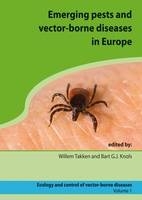
Emerging pests and vector-borne diseases in Europe
Seiten
2007
Wageningen Academic Publishers (Verlag)
978-90-8686-053-1 (ISBN)
Wageningen Academic Publishers (Verlag)
978-90-8686-053-1 (ISBN)
- Keine Verlagsinformationen verfügbar
- Artikel merken
Covers the threat and increase of emerging pests and vector-borne diseases affecting man and animals in Europe. This book provides examples of the most likely pests and diseases affecting man and animals in Europe, with emphasis on ecological factors favouring these diseases and methods for prevention and intervention.
"This is a multi-authored book concerning the perceived threat and recorded increase of emerging pests and vector-borne diseases affecting man and animals in Europe.
Historically, Europe suffered from numerous pests and vector-borne diseases, including yellow fever, malaria, plague and typhus. Introduction of hygienic measures, drugs and vector control caused the disappearance of many of these diseases from Europe. In the (sub)tropics, however, many of these diseases still thrive, causing serious health problems for humans and animals. Increased trade, leading to animal and human movement and climate change cause reason to assume that several of these diseases might become re-established or allow 'new' diseases and pests to be introduced in Europe. The recent outbreaks of bluetongue virus in North-western Europe highlights this concern, requiring an effective surveillance systems for the early detection of pests and vector-borne diseases.
In 24 chapters this book provides examples of the most likely pests and diseases affecting man and animals in Europe, with emphasis on ecological factors favouring these diseases and methods for prevention and intervention. The authors are recognized experts in specific fields. All chapters are peer reviewed."
"This is a multi-authored book concerning the perceived threat and recorded increase of emerging pests and vector-borne diseases affecting man and animals in Europe.
Historically, Europe suffered from numerous pests and vector-borne diseases, including yellow fever, malaria, plague and typhus. Introduction of hygienic measures, drugs and vector control caused the disappearance of many of these diseases from Europe. In the (sub)tropics, however, many of these diseases still thrive, causing serious health problems for humans and animals. Increased trade, leading to animal and human movement and climate change cause reason to assume that several of these diseases might become re-established or allow 'new' diseases and pests to be introduced in Europe. The recent outbreaks of bluetongue virus in North-western Europe highlights this concern, requiring an effective surveillance systems for the early detection of pests and vector-borne diseases.
In 24 chapters this book provides examples of the most likely pests and diseases affecting man and animals in Europe, with emphasis on ecological factors favouring these diseases and methods for prevention and intervention. The authors are recognized experts in specific fields. All chapters are peer reviewed."
| Erscheint lt. Verlag | 29.10.2007 |
|---|---|
| Reihe/Serie | Ecology and Control of Vector-borne Diseases ; 1 |
| Sprache | englisch |
| Maße | 170 x 240 mm |
| Gewicht | 1 g |
| Themenwelt | Studium ► Querschnittsbereiche ► Prävention / Gesundheitsförderung |
| Veterinärmedizin ► Klinische Fächer | |
| Weitere Fachgebiete ► Land- / Forstwirtschaft / Fischerei | |
| ISBN-10 | 90-8686-053-2 / 9086860532 |
| ISBN-13 | 978-90-8686-053-1 / 9789086860531 |
| Zustand | Neuware |
| Haben Sie eine Frage zum Produkt? |
Mehr entdecken
aus dem Bereich
aus dem Bereich
das Manual zur psychologischen Gesundheitsförderung
Buch | Hardcover (2023)
Springer Berlin (Verlag)
39,99 €
Orthomolekulare Medizin in Prävention, Diagnostik und Therapie
Buch | Hardcover (2022)
Thieme (Verlag)
71,00 €


